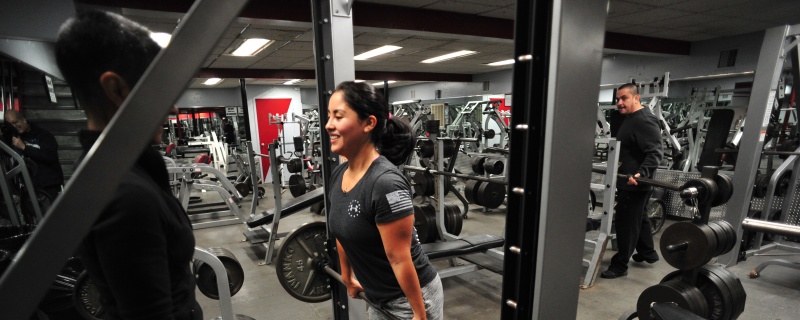
Muscle hypertrophy is a term for the growth and increase of the size of muscle cells. This is mainly brought on through weight training.
So how do muscles get stronger?
How can we use this information to help our clients who want to get stronger, but not bigger? We have to consider the amount of weight lifted, the number of reps, and the rest period.
The Size Principle implies that to get stronger we need to activate all of the motor units, and that requires a heavy enough weight, or great enough resistance, to trigger the high-threshold, type II motor units. This is why the standard recommendation for load is >85% 1 RM. Furthermore, lifting a near maximal weight will provide the additional benefit of stimulating synchronous activity of motor unit recruitment. In order for maximal force to be generated, all motor units in a given muscle must be activated at close to the same time. In an untrained individual, motor unit activation will occur at slightly different times, and therefore lead to inefficient movement. This works much like rowers in a boat rowing in synch vs. the rowers rowing at different times. One of the simplest ways to enhance motor unit synchronization is through heavy load resistance training.
As a side effect of lifting near your one repetition maximum, the number of repetitions you will be able to perform will naturally be fewer. Think about it: your one repetition maximum literally means that most weight you can lift one time. Therefore if we are lifting a weight that is near our one rep max, repetitions will be kept to a minimum simply because the resistance is too great to generate numerous successive repetitions. Generally speaking, if you are able to lift a resistance more than six times in a row, it is not heavy enough to stimulate your highest threshold motor units nor force synchronous motor unit activity. A word of caution: however, near maximal lifting (>85% 1 RM) can be dangerous for a novice lifter, and thus one should have some training experience before attempting to develop maximal strength through this manner.
Now, what about the two to five minutes rest interval recommendation?
This can be related to our understanding of the metabolic pathways, specifically regeneration of adenosine triphosphate and creatine, but that can get a little complicated.
An easier way to explain it is that the central nervous system needs full recovery in between sets in order for coordinated motor unit activity and maximal motor unit recruitment to occur in the subsequent sets6. Maximal strength output requires optimal performance of both variables. Lastly, the stronger an individual is, the more rest he or she will likely need between sets when working with a near maximal resistance.
And how do muscles get bigger?
Now you might be thinking that this is common sense, right? Lifting heavy weights make you stronger, but is this also the best strategy for getting bigger muscles?
The quick answer is no. It is not likely that following the recommendations for increasing muscle strength will lead to optimal muscle hypertrophy. Here’s why:
Resistance training initiates protein degradation, the breakdown of muscle tissue and in turn creates the right conditions for rebuilding bigger muscles during rest and recovery periods.
Protein in muscle tissue breaks down with strength training and only then can it rebuild itself into bigger tissue. The amount of protein degradation that occurs depends on how we approach our training. Obviously, the extent to which our muscle rebuilds depends on the quality of our post training recovery (an issue separate from the discussion taking place in this article).
Protein breakdown is stimulated by two different factors:
With this in mind, in order to make our muscles bigger, we need to use a weight that is not only heavier, but also one that we can lift for a high number of reps.
This is the reason why the load and rep recommendation of 67%-85% 1 RM for 6-12 reps is the starting guideline for muscle hypertrophy.
This load/rep ratio satisfies the two factors that stimulate protein degradation: heavy weight, high rep scheme, so that you get maximum muscle building during recovery. As you can see, while lifting a near maximal load (>85% 1 RM) for low repetitions (i.e. <6) would meet the first requirement needed to stimulate protein degradation, it would not meet the second requirement, and therefore is not the theoretical optimal load/volume ratio to be used to stimulate maximum hypertrophy. On the other hand, lifting a light weight (i.e. <67% 1 RM) for a high number of repetitions (i.e. 25 reps) would meet the second requirement needed to stimulate protein degradation, but not the first requirement, and therefore is not the theoretical optimal load/volume ratio to use to stimulate maximum hypertrophy.
The rest interval recommendation for hypertrophy is 30 to 90 seconds. Why less recovery time than for increasing muscle strength?
Well, one reason is that some studies have shown this rest interval range leads to elevated levels of serum growth hormone during exercise (6). Growth hormone is important in stimulating muscle growth, hence the resulting hypertrophy.
This information is the property of ISSAONLINE.EDU
Written by: Alex Hoffmann who holds a Master's degree in Kinesiology from California State University and is currently an instructor at International Sports Sciences Assosiation. (ISSA)
I am a ISSA Certified trainer and not representing ISSA itself.